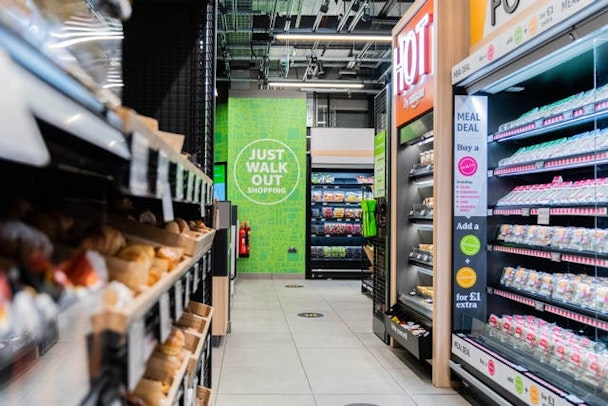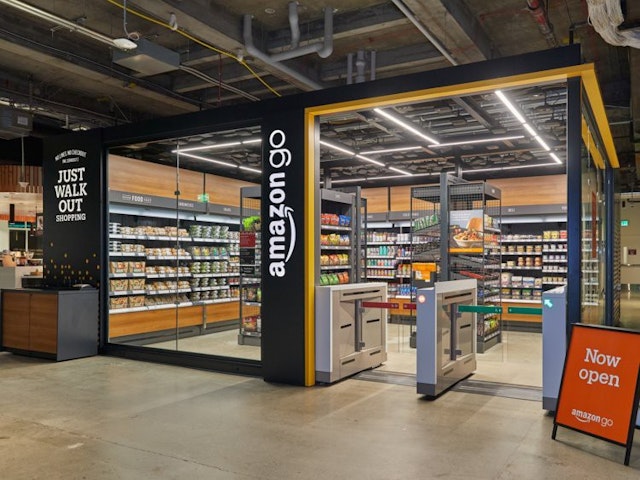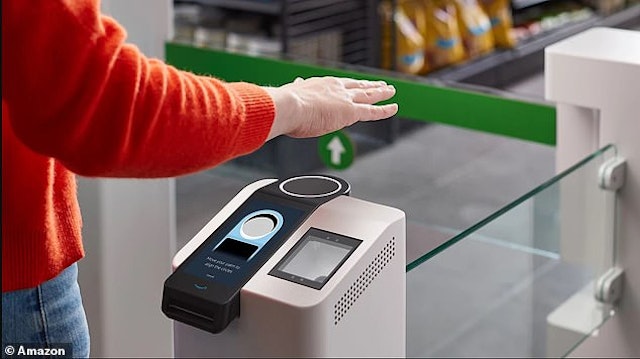Is the Amazon Go cashierless-store concept the future of retail or just another fad?
Amazon has paved the way for ’just walk out’ shopping and now all manner of retailers are experimenting with cashierless stores. As part of our Retail Deep Dive, we ask experts: is it the future of shopping, or just another retail fad?

Amazon Go
Amazon opened its first cashierless store in the UK earlier this year (check out The Drum editor-in-chief Gordon Young’s experience here) and since then the likes of Tesco and Morrisons have committed to trials of the technology. Some experiments have already gone awry, however, Sainsbury’s having abandoned its cashierless stores after tests in early 2019 led it to admit “not all our customers are ready for totally till-free“.
So what does the future hold? The Drum caught up with industry experts for their take.
Michelle Whelan, UK chief executive, VMLY&R Commerce
Attitudes to cash changed during the pandemic – the majority of UK consumers now prefer to go cashless. The pandemic also accelerated innovation in payments, fueling the development of low-touch transaction systems with an emphasis on consumer experience. According to UK Finance research, the number of transactions using coins and notes fell by 35% last year, while contactless methods accounted for more than a quarter of all payments.
This is not a flash in the pan. Gen Z and millennials were adopting mobile payments long before Covid, regularly using technology-enabled payment methods embedded in their phones. They see cash as redundant and therefore an encumbrance.
Looking east, everything in China is now cashless thanks to two giant payment platforms – Alipay (Alibaba) and WePay (WeChat) – that own 90% of the market. The payment mechanic is typically a QR code, whether it is a local street vendor selling home cooked food or a QSR restaurant such as KFC.
Over the last months there has been real advancement in the cashless transaction space. Suning.com in Nanjing (China’s third largest e-commerce platform) has recently completed a successful trial of cashless payments involving facial recognition.
In the UK, Amazon’s ‘just walk out’ technology is far from being alone and is in its infancy. A cashless society is not a fad. Arguably it’s a necessity to stay relevant with new audiences and has a role to play in shouldering the future of retail.

Jessica Chapplow, head of e-commerce, Havas Market
There’s no doubt that ’just walk out’ shopping has benefits for retailers and customers alike.
For retailers, the supply chain becomes far more optimized to the store when it comes to these cashless experiences, and the combination of AI and IoT technologies to power walk-out technologies also provides more data on stock and products’ shelf life, enabling them to ensure that 100% of their shelf space is allocated. Staff can also receive real-time inventory updates.
Ultimately, the walk-out model offers retailers far more behavioral data, going beyond what can traditionally be collected from POS systems. Brands can gain insight into what products are picked up and returned to shelves, how long the customer stands in front of what shelves and what products they select as a result, as well as better understanding the in-store behaviors of visitors who exit without making a purchase. This could level the playing field between online versus offline analytics and insights, offering the type of information that retailers could previously only obtain via their e-commerce websites.
For consumers, cashless stores add convenience and personalization to the shopping experience, with shoppers matched to their online shopping accounts and purchase histories. However, retailers (particularly those outside of the grocery space) and merchants will need to reassure people visiting their stores that they are taking the necessary steps to keep their data safe.
Providing a human element is the logistical advantage and key differentiator that physical stores have always had over e-commerce platforms. Consumer adoption of cashless stores will require retail brands to strike the balance between providing a quick, seamless experience and meeting customers’ desires for human interaction. Otherwise, this new way of shopping may become just another passing fad.
India Doyle, deputy editor of consumer insights agency, Canvas8’s Library
Walk in/walk out retail embodies the battle between desires for hyper convenience and Covid safety and a deep need for human connection and sense of community in an era of loneliness. We know from the boom of 15 minute delivery and the rise of Amazon Prime that there’s a growing expectation from people that retail should be instant and seamless. And that behavior has helped to fuel the growth of cashless, walk in/walk out stores.
While they are convenient, the question is what needs will they serve for that consumer group who is already now comfortable with, and in the habit of using, instant online delivery? If people can get everything they want delivered to their door in 15 minutes, the allure of the supermarket – however convenient – is lessened. Plus the emergence of the hybrid working model means commuters are less likely to be doing a supermarket sweep in a hurry after work and more likely to want groceries delivered to their homes.
Research found that 52% of British shoppers want to return to shopping in store after a year of lockdown, and there’s also a need for retailers to think about the element of digital exclusion that cashless stores introduce – research by the Post Office for example found that 40% of Londoners still rely on cash on a weekly basis and 1.4 million people in the UK don’t have a bank account. At a time when people also want businesses to help solve social issues and help to create more equitable and inclusive communities, small details such as making payments accessible to everyone are important to keep in mind.

Nick Blenkarne, creative strategy director, Imagination
What might have initially seemed like a slightly gimmicky niche store concept has now become a very real prospect for traditional retailers. There are a series of experiments ongoing from the ’Big 4’. Tesco and Morrisons are trialing a cashierless sensor and camera-based store akin to Amazon Fresh, and Sainsbury’s tested a mobile-pay only store in Holborn.
But the real test of long-term adoption will be the extent to which ’just walk out’ genuinely improves the shopping experience for customers and provides value to retailers in a way that outweighs the high implementation costs.
For customers, the promise of a more frictionless experience with no queues is balanced by some apprehension, at least in the short term. ’All these cameras feel a bit creepy.’ ’Have I been charged properly?’ ’It’s very cold and clinical.’ Those concerns might well dissipate over time as it becomes normalized and trust builds. But there’s also the barrier of systems that require customers to have an app and online account to enter a store. Sure, most people already have an Amazon account, but if all retailers do go down that route, forcing customers to download yet another supermarket app to allow entry could prove off putting.
For retailers, the benefits in terms of data are huge. Being able to target and personalize stock based on local user needs can lead to much lower stock wastage, and the ability to retarget them online based on in-store behaviors offers great sales potential. But the cost of rolling out sensors, cameras, turnstiles and all of the other hardware required will be astronomical.
As cash becomes phased out of societies in general, retailers will follow suit, but they also don’t want to alienate customers who aren’t there yet. With more wholesale changes like ’just walk out’, we will continue to see retailers experiment with a mix of store concepts, but until the consumer concerns are ironed out and the right combination of investment versus return is figured out, the jury is out whether this particular incarnation will proliferate.
Jo Arden, chief strategy officer, Publicis.Poke
‘Just walk out’ shopping is very cool. It’s like magic. The power of technology to solve problems of this scale makes my mind boggle. Except, I’m not sure it is solving any problem at all. If anything, I suspect it will compound some pretty serious problems that already exist. The last 12 months have been the worst in 25 years for retail job losses. While Amazon’s UK workforce is projected to hit 50,000 this year, those jobs do little to replace the opportunity and sense of community that vanishes with the loss of more traditional retail job roles. Covid is not the only pandemic we face; loneliness shows no signs of abating. There is something cruelly ironic too about the arrival of ‘contactless shopping’ after 18 months (and counting) when most people have craved more, not less, in-person contact. If we now no longer even have the time to swipe, tap and maybe chat as we pick up a sandwich given the year we’ve had, our priorities as people need some serious re-examining. There are so many ways in which tech could add to the retail experience and I’d like to see this same ingenuity applied to building more, not less human connection.

